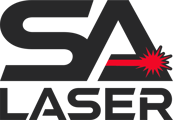Introduction
Cylinder correction warps the output of your design to correct for the expansion that happens when marking on a cylindrical object like a cup or a tumbler without using a rotary. This feature is dependent on being able to mark on your target across a potentially wide focal range, making lens selection an important consideration. The larger the lens, the wider your laser's focal range will be.
Step-by-Step Guide
Step 1: Find Your Mirror Distance
- Set Your Focus: Set your focus from your work bed or workpiece, whichever you prefer.
- Remove the Lens: Carefully remove the lens from the galvo head and place it aside.
- Measure the Distance: Measure from the center of the beam tunnel down to where you set your focus. This measurement is your mirror distance value. If your laser has no cover on the galvo head, measure from your focal point to the center of the tube connecting the Laser Source to the galvo head.
- Example Measurements:
- 300 mm lens: 20 and 38 inches (20 + 38) / 2 = 29 inches (approximately 737 mm)
- 200 mm lens: 15 inches (approximately 381 mm)
Step 2: Cylinder Correction Setup
- Import Your Graphic: Bring your graphic into LightBurn and size it appropriately to your workpiece.
- Select the Graphic: Ensure the graphic is still selected.
- Open Cylinder Correction Setup: Click on the cylinder correction setup icon and enable cylinder correction.
- Enter Measurements: Enter the mirror distance and diameter values. If you have the circumference, calculate the diameter using the formula: Circumference / π = Diameter.
- Choose Cylinder Axis: Select which axis your cylinder will be curving and indicate if the engraving surface is convex or concave.
- Optional Boundary Box: Click the 'Show Valid Boundary' button to place a tool line bounding box around your graphic, based on the values you entered. The boundary should be slightly larger than the diameter of your cylinder. If your graphic exceeds these boundaries, it will be cut off at the borders.
- Apply Settings: Click 'OK' to apply the cylinder correction and close the setup window.
Step 3: Position and Focus
- Position the Graphic: Click 'Frame' with the bounds option and position the graphic where you want it on your cylindrical workpiece.
- Set Focus: Center your focus between the highest and lowest points of your graphic on the cylindrical workpiece. Proper focus ensures that your laser does not go outside the focal range at any point on the cylinder.
Step 4: Apply Engraving Settings
- Set Engraving Settings: Apply your desired settings for engraving.
- Preview: Click the preview button to see your graphic warping according to the cylinder size and position in the work area.
- Start Engraving: Once satisfied, click 'Start' to begin engraving.
Conclusion
Following these steps ensures accurate cylinder correction for laser engraving on cylindrical objects, compensating for any expansion and maintaining the integrity of your design. Proper lens selection, mirror distance measurement, and focus setting are crucial for successful cylinder correction.
